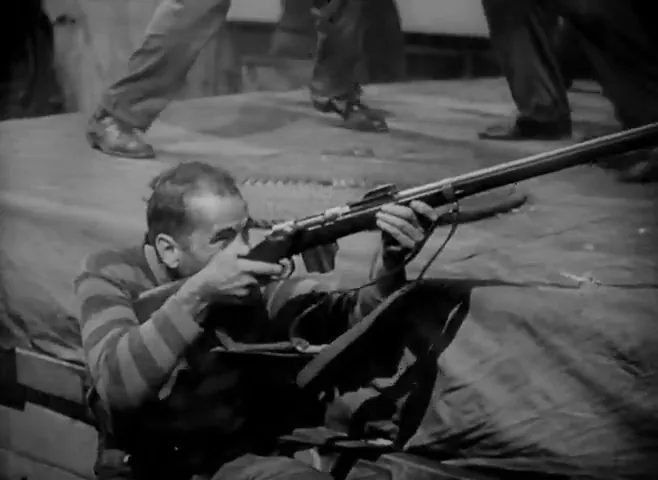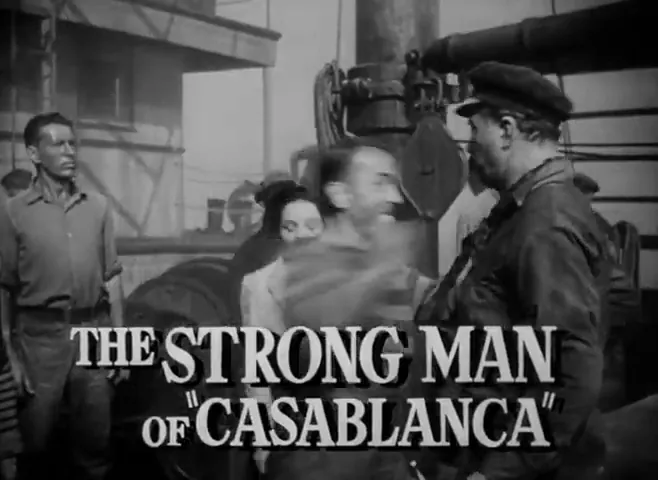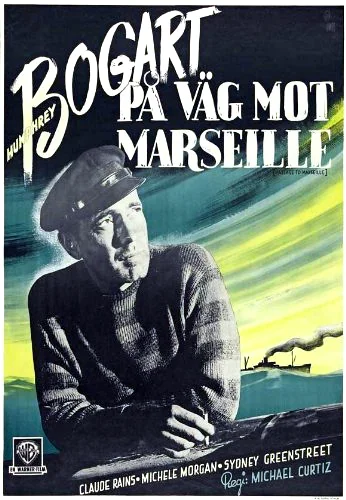🎯 Quick Overview
Trailer
- Director: Michael Curtiz
- Genre: Drama, War, Adventure, Romance
- Release year: 1944
- Runtime (length): 1h 49min
- IMDb rating: 6.8/10 (5.3K votes)
- Rotten Tomatoes: 75%
😅 Plot Summary – Badly Explained
A bunch of rugged French escapees (mostly played by non-French actors) get lost in flashbacks within flashbacks only to end up fighting Nazis on a ship instead of going home.
🍿 Passage to Marseille: Detailed Plot Synopsis
A French Bomber Squadron in England
The film opens at a Free French air base in England, disguised as a farm. War correspondent Manning arrives to interview Captain Freycinet, the liaison officer. As planes prepare for a mission, including a bomber piloted by Renault and gunner Jean Matrac, Freycinet offers to tell Matrac’s extraordinary story.

The Rescue at Sea and the Complex Narrative
Captain Freycinet’s story begins during the early days of WWII aboard the freighter *Ville de Nancy*, bound for Marseille. While at sea, they rescue five emaciated men adrift in a small boat: Jean Matrac, Renault, Marius, Petit, and Garou. Major Duval, a passenger on the ship, suspects they are fugitives from Devil’s Island. The film employs a notable multi-layered flashback structure, with Freycinet recounting the story to Manning, and the rescued men, particularly Renault, providing further flashbacks about their pasts and escape.

Life and Escape from Devil’s Island
Through the flashbacks, the grim realities of the penal colony in French Guiana are depicted. The men reveal their backgrounds: Petit, a farmer exiled for protesting land confiscation; Marius, a safecracker; Garou, a mechanic imprisoned for murder; and Renault, a WWI deserter who joined the Foreign Legion. They were recruited into an escape plan by Grandpere, an elderly patriot who saved money to buy a boat, demanding a vow to fight for France in return.

Jean Matrac’s Background and Imprisonment
The most detailed flashback concerns Jean Matrac, revealed to be a respected French journalist who published a newspaper opposing the Munich Pact and accusing the government of appeasement. His office was violently attacked by thugs while police stood by. Falsely framed for murder, Matrac was convicted and sent to Devil’s Island, separating him from his wife, Paula, whom he married shortly before his arrest.

The Voyage and News of the Armistice
Back on the *Ville de Nancy*, the rescued escapees earn the trust of Captain Malo and Captain Freycinet, who are sympathetic to their desire to fight for France. While at sea, they receive news that France, under Marshal Pétain, has signed an armistice with Germany. Captain Malo secretly changes course for England to join the Free French forces.
Conflict Aboard the Ship
Major Duval, a staunch supporter of the Vichy government, attempts to seize control of the *Ville de Nancy* to divert it to Marseille and align with the collaborationist regime. A violent struggle ensues between Duval’s supporters and the patriotic crew and escaped convicts. The patriots regain control, but not before a radio operator manages to broadcast their position.
⚠️ Spoilers and Ending Explained
🎬 Cast & Characters
- Jean Matrac (Humphrey Bogart): A patriotic French journalist, framed and sent to Devil’s Island, who escapes to fight for Free France.
- Capt. Freycinet (Claude Rains): A sympathetic Free French officer who narrates the story of Matrac and the escaped convicts to a journalist.
- Maj. Duval (Sydney Greenstreet): A staunch Vichy sympathizer who attempts to seize control of the ship bound for Marseilles.
- Renault (Philip Dorn): One of the patriotic convicts who escapes Devil’s Island with Matrac and becomes a Free French pilot.
- Marius (Peter Lorre): A fellow convict who escapes Devil’s Island and joins the fight for Free France, demonstrating unexpected patriotism.
- Paula Matrac (Michèle Morgan): Jean Matrac’s devoted wife in occupied France, who serves as his primary motivation for fighting.
💬 Memorable Quotes
- Opening Title Card: “For a nation exists, not alone in terms of maps and boundaries, but in the hearts of men.” – Displayed at the beginning of the film to establish its patriotic and thematic core.
- Renault: “Any day that takes us closer to France is a fine day.” – Said with longing and hope by one of the escaped convicts eager to return to their homeland.
- Jean Matrac: “To my wife. Till we meet again.” – The text of a message Matrac attempts to drop from his bomber over his hometown for his waiting wife.
- Capt. Malo: “What are you doing? You cannot assassinate helpless men!” – Exclaimed in shock by the ship’s captain when Matrac begins shooting the German airmen who survived the crash.
- Jean Matrac: “Look around you, Captain, and see who are the assassins.” – Matrac’s defiant response to Captain Malo, justifying his actions by pointing to the destruction caused by the German attack.
💰Box Office
- Budget: N/A
- Domestic Gross: N/A
- Worldwide Gross: N/A
💥 Passage to Marseille Reviews
Personal Review
Okay, so I finally watched “Passage to Marseille” because, come on, Bogart, Rains, Greenstreet, and Lorre together again? Sign me up! Yeah, those flashbacks within flashbacks were *a lot* to keep straight at first, I won’t lie. My brain felt like it was doing gymnastics trying to figure out whose story we were in at any given moment. But once I just went with it, the Devil’s Island stuff was pretty intense, and the whole plot about these convicts just wanting to fight for France against the Nazis was actually really moving. The ship battle towards the end was legitimately exciting! And Bogart’s character doing *that* thing to the German pilots was totally shocking, like, whoa. It really hits home that war is messy and complicated, not just heroes doing heroic things. It’s not “Casablanca,” sure, but it’s got its own punch and is a fascinating look at wartime filmmaking.
- Who would enjoy:
- “Fans of classic Hollywood films”
- “Humphrey Bogart enthusiasts”
- “Viewers interested in World War II history and propaganda films”
- “Those who enjoyed Casablanca and want to see the cast together again”
- “Fans of escape and adventure stories”
- Content warnings ⚠:
- “Depictions of violence and death typical of a war film”
- “Intense scenes set in a penal colony (Devil’s Island)”
- “Controversial scene depicting the killing of enemy survivors”
- “Thematic focus on war, imprisonment, and political persecution”
Professional Reviews
- Inspired by classic film criticism: “While perhaps unfairly overshadowed by its more famous predecessor, “Passage to Marseille” nonetheless delivers a compelling wartime drama. Curtiz’s direction shines in the action sequences, particularly the ship battle and plane attack. Though the layered flashback structure can be disorienting, strong performances from the familiar Warner Bros. ensemble, especially Claude Rains, elevate the material. It’s a solid piece of wartime propaganda, offering insight into the era’s perspective.
- Inspired by film review sites: “Despite a somewhat convoluted narrative structure, “Passage to Marseille” is a watchable and often thrilling experience. The chemistry between the ‘Casablanca’ alumni is undeniable, even if their characters feel less developed here. The film’s raw portrayal of wartime brutality, particularly a controversial scene involving enemy survivors, is surprising for its time. While not a masterpiece, its technical skill, particularly the cinematography, makes it worth seeing for fans of classic Hollywood and WWII films.
Audience Reactions
The action sequences, especially the ship battle and plane attack, were a major highlight.: Many viewers appreciated the performances by the familiar cast, particularly the ‘Casablanca’ actors.
The film’s intense moments and surprising brutality left a strong impression.: Despite the confusing flashback structure, audiences found the core story of patriotism and sacrifice compelling.
Overall Consensus: A mixed bag, often compared to ‘Casablanca,’ criticized for its complex flashback structure, but praised for strong performances, exciting action, and its powerful patriotic message.
Awards
🛠️ Behind the Scenes
- “Warner Bros. built a full-scale Merchant Marine ship set over three months for the film.”
- “The movie famously employs a complex narrative structure featuring multiple nested flashbacks.”
- “Many key actors, including Humphrey Bogart, Claude Rains, Sydney Greenstreet, and Peter Lorre, were not French and did not attempt French accents for their roles as French characters.”
- “The penal colony scenes were filmed at the Los Angeles County Arboretum & Botanic Garden.”
- “Corinna Mura, who sang ‘La Marseillaise’ and ‘As Time Goes By’ in ‘Casablanca’, appears uncredited as a cafe singer in this film.”
- “The film includes a controversial scene where Bogart’s character machine-guns German survivors after their plane is shot down, a moment that sparked debate even at the time.”
🖥️ How to Watch Passage to Marseille?
As a classic film from Warner Bros., ‘Passage to Marseille’ may be available through various streaming platforms that license older studio libraries. Look for it on services like Max (formerly HBO Max), or potentially the Criterion Channel. It is also explicitly available to search on Amazon, suggesting digital purchase or rental options via Prime Video. Check platforms like Apple TV, Google Play Movies & TV, and Vudu for rental or purchase availability.

🎥 Similar Movies
If you enjoyed Passage to Marseille, you might like these similar films:
- Casablanca (1942): Directed by Michael Curtiz and starring Humphrey Bogart, Claude Rains, Sydney Greenstreet, and Peter Lorre, this film shares key cast, director, genre, and themes of patriotism and resistance during WWII.
- The Maltese Falcon (1941): Features the iconic trio of Bogart, Lorre, and Greenstreet in a classic noir mystery, appealing to fans of the era and cast’s collaborative chemistry.
- Papillon (1973): Based on a memoir of escape from the French penal colony in French Guiana, it shares the core theme of brutal imprisonment and the desperate fight for freedom and survival.
- To Have and Have Not (1944): Another Bogart film set during WWII in a French territory (Martinique), involving smuggling and individuals reluctantly drawn into the resistance against the Axis.
- Black Book (Zwartboek) (2006): A modern European film depicting the harrowing experiences of a Jewish spy within the Dutch resistance during WWII, sharing themes of patriotism, moral compromise in war, and fighting for a conquered nation.
🛒 Passage to Marseille Related Products
- Passage to Marseille DVD or Blu-ray: Own the classic Warner Bros. wartime drama, featuring the iconic cast reunited after Casablanca. Remastered for modern viewing.
- Humphrey Bogart: The Essential Collection: A box set featuring many of Bogart’s most famous films, including other wartime and noir classics.
- Men Without Country (The Passage to Marseille Novel): The original novel by Charles Nordhoff and James Norman Hall that inspired the film.
- World War II History Books (Focus on French Resistance): Explore the historical context of the film’s themes of French resistance and the complexities of the Vichy government.
🎧 Soundtrack
Passage to Marseille features a captivating soundtrack that enhances the movie’s atmosphere and emotional impact. Here are some notable tracks:
- “Someday I’ll Meet You Again” – performed by Corinna Mura
- “La Marseillaise” – performed by Traditional
- “Marche Lorraine” – performed by Traditional
You can find the complete soundtrack on Amazon Music and Apple Music.
🤨 FAQ
No, ‘Passage to Marseille’ is not a direct sequel to ‘Casablanca’. However, it features several key cast members from ‘Casablanca’ (Humphrey Bogart, Claude Rains, Sydney Greenstreet, Peter Lorre, and even singer Corinna Mura) and was directed by Michael Curtiz, leading many viewers to compare the two films. It’s a distinct story set during WWII focusing on French patriots.
‘Passage to Marseille’ uses a complex, multi-layered flashback structure, with flashbacks occurring *within* other flashbacks. The main story is framed by a journalist interviewing a captain, who tells a story that includes the escaped convicts recounting their own pasts. This narrative technique was criticized by some viewers as difficult to follow and disjointed.
Humphrey Bogart, playing the French character Jean Matrac, does not attempt a French accent in the film. This was common practice in classic Hollywood for leading American actors playing foreign roles. While other actors in the film use varying accents (some attempting French, others retaining their native accents), Bogart speaks in his standard voice, which is often noted by viewers.
Yes, ‘Passage to Marseille’ was made in 1944 during World War II and serves as a strong piece of Allied propaganda. It highlights the unwavering patriotism of the Free French forces and contrasts them with the collaborationist Vichy regime. The film aims to portray French citizens, even those with troubled pasts, as dedicated fighters against Nazism.
During a battle on the ship against a German bomber, the German plane is shot down. As the surviving German airmen climb onto the wreckage in the water, Humphrey Bogart’s character, Jean Matrac, machine-guns them despite the ship captain’s protests. This scene, depicting the killing of defenseless survivors, was considered shocking and has been a point of discussion regarding Matrac’s character and the realities of war.
🔥 Bonus Content
Art, Fashion, & The French Revolution
Want to really get a feel for the historical period in Children of Paradise? This video is awesome because it digs into the art and wild fashion of the French Revolution era, helping you understand the world these characters lived in – I found it totally fascinating!
✨ Rate
There are no reviews yet. Be the first one to write one.





